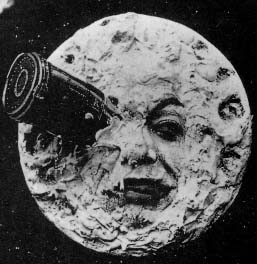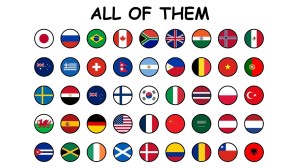Pioneering French filmmaker Georges Méliès, seen here playing two roles in his 1902 film “L’homme à la tête de caoutchouc” (aka The Man with the Rubber Head), made more than 500 films between 1896 and 1914. The film Hugo, one of 2011’s most award-nominated films, features Georges Méliès as a character and shows excerpts of some of his most famous films.
Méliès began his career as a magician, and in The Vanishing Lady, one of his first films, he recreates a classic magic trick with the latest in film editing sorcery: the jump-cut.
In another early film, The Haunted Castle (aka Le manoir du diable), also from 1896, Méliès uses more tricky edits to bring characters in and out of the film, sometimes in a puff of smoke and usually startling the trespassers in the nefarious castle. Very mild suspense elements by today’s standards, but nonetheless groundbreaking. This film is considered both the first horror film and the first vampire film. It’s the first (not last) fake-bat-on-a-string-that-turns-into-a-man film, for sure.
Méliès innovated constantly in his work: he was one of the first to use multiple exposures, time-lapse photography, dissolves, and hand-painted colour. Keep in mind the first film shot with a motion picture camera was in 1888–these were very early days. His films had no sound, if they were accompanied by music in theaters it was played live and was different each time. So any music on these videos is a much later addition.
Hugo features scenes from 1902’s A Trip to the Moon, probably Méliès’ most famous film:
[A Trip to the Moon] includes the celebrated scene in which a spaceship hits the the man in the moon in the eye; it was loosely based on Jules Verne’s From the Earth to the Moon and H. G. Wells’ The First Men in the Moon. In the film Méliès stars as Professor Barbenfouillis, a character similar to the astronomer he played in The Astronomer’s Dream in 1898.
The film was distributed in black & white and hand-painted color prints. No color prints were known until a discovery in 1993. After 10+ years of work a restored color print debuted at the 2011 Cannes Film Festival with a new soundtrack by the band Air. See a clip below and the full black & white film here. The whole film is also available at The Internet Archive.
One topic not covered in Hugo is that this film was an early subject of film piracy, perpetrated by none other than Thomas Edison. This was a contributing factor to Méliès’ financial ruin and the end of his film-making career. Ironically, if not for the pirated versions we probably wouldn’t have copies of many of the 200 of his films that survive today.
Other notable Méliès films include the fairy tales Cinderella (1899) and Bluebeard (1902), Le dirigeable fantastique (1905) and 1911’s Les hallucinations du baron de Münchhausen–the first of many films made about a real German nobleman’s exaggerated adventures.
Finally, one last colorful short Danse du feu from 1899, which like The Vanishing Lady above features his future wife Jeanne d’Alcy who is also a character in Hugo.








